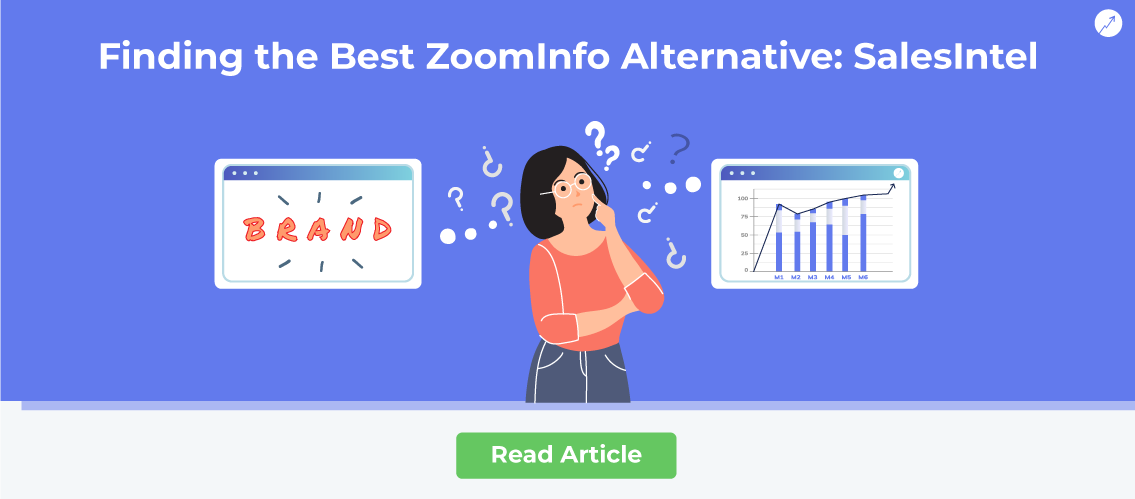In theory, tracking buying signals seems too simple. Concentrate on the hot prospects that suit the ideal customer profile. That’s it. However, marketers and sales reps often fail to sense and track the buying signals from potential leads and prospects. As a result, they fail to convert opportunities that could have generated revenue.
It is not just about identifying the buying signals, but it is also about identifying the buying signals at the right time. We’ll cover what you should track, but first, how do we define buying signals?
Defining Buying Signals
Buying signals are indications that a customer is ready to make a purchase. They can include verbal cues such as asking about pricing or availability, nonverbal cues such as leaning towards a product, or specific actions such as adding items to a shopping cart. Understanding buying signals can help salespeople close deals and increase revenue.
Buying signals occur throughout the buyer’s journey. Data intelligence tools such as SalesIntel can capture signal data, such as website interactions, and consolidate them into a lead score. A lead score is a way to then prioritize prospects and leads for your team.
10 Buying Signals You Should Track
Now that you have an idea about buying signals, you need to identify what type of signals you should consider. Here are ten of the best digital and organizational buying signals you can consider to capitalize on the opportunities.
These buying signals will help you bring personalization to your cold calls, video messaging, and emails, as well as fine-tune your outreach sequences to be more appropriate, specific, and timely
1. Changes in Leadership
Whenever there are management changes, expect big things to come and an opportunity for sales. New high-level employees always bring new goals, approaches, and perspectives to the company. Make sure you track changes in the leadership at your target accounts as shifting to a new vendor and a new budget is always around the corner in such scenarios.
You can also keep a check on the decision-makers from the existing clients’ side. When a decision-maker positively shifts the company, they are likely to get a promotion and may open up a new opportunity for you to upsell.
2. Track Your Competitor’s Contract Termination
You are about to close a deal, and it’s you and your competitor in the final round. You know you have a superior product. However, you find out that you have lost the opportunity because of the price. Now, although you have close lost the account, you know that the competitor will likely have key issues. Tracking the contract can bring an opportunity for you. Reach back out two months before the contract ends and see if they’re ready for a change.
Changes in tech stack or products always open new opportunities. Make sure you know who’s using apps that integrate well with you– and who are using your competitors’. Use your background research to convince a prospect based on your product’s superiority over the competition. Remind them there’s always another option.
You can also use SalesIntel to find the technographic data of your prospects. You can filter by your competitor’s name to get the list of best potential leads. If you don’t have a particular competitor in mind, you can filter through the market in which a product or technology is used.
3. Key Email Interactions
Simply having a prospect open an email is a weak signal of buying intent. But repeatedly interacting and clicking links increases their likelihood to buy. The signal is stronger if they’re interacting with a targeted email sequence instead of general content.
Let’s use the previous example. You have identified companies using your competitors’ products in the SalesIntel portal. For example, you are selling a CRM, and you have an XYZ product as your competitor. You can identify companies using your competitor’s product, and then go to review platforms, analyze their weaknesses, and what their customers are going through. Then, you can come up with an email campaign targeting those pain points and promote articles showing an honest comparison between the products.
For instance:
4. Engagement With Your Website and Articles
According to studies, before engaging with a salesperson, an average B2B prospect is already 67% of the way into the purchasing journey. How can you reach prospects earlier in their buying process?
Tools like Google Analytics help you find out demographic information of your website visitors and the basics of their experience on your site.
While Google Analytics is often used by almost every company, you can go a step further and use tools like VisitorIntel to track down your visitors and connect them to other buyer signals. Such tools let you know which companies have had multiple people visit and engage with your site. With extra visibility into which companies are visiting, you can proactively begin your outreach.
5. Interest in a Particular Use Case
If a prospect is interested in a specific use case or a success story on your site, it implies strong intent. You want to track when a particular topic resonates more than usual with a prospect.
For example, if you are promoting a specific use case through a series of emails, and X company is repeatedly opening or interacting with the email then you can consider this as a high buying intent signal.
If you combine buying signals, you could see that a prospective company opened multiple emails on a topic, visited a case study site page, and downloaded a white paper about the topic. The focus on a particular topic likely means they are already closer to a buying decision and know what they are looking for.
6. The Prospect Signed up for a Free Trial
Signing up for a free trial or other complimentary offers from a lead capture page shows that the prospect is intensely interested.
But if the prospect does not take advantage of the trial right away, it does not mean they have lost confidence. It might be because they don’t know how to use the product properly. Consider enrolling someone who signs up for a trial in an automated email sequence that offers tutorials or advice to help reduce this danger.
You can also provide them with free one-on-one consultations or phone calls with a customer service agent who can walk them through the trial. A more tailored experience can help certain prospects close faster.
7. Social Media Engagement
A lot of companies consider social media activities as a daily routine and keep posting for brand awareness. However, only a few aim to identify available opportunities.
If you notice that one of the companies that match your ideal customer profile has started following your company’s social media profile (LinkedIn, to be precise), engaged with the content you publish, or started mentioning you then the prospect is likely interested in your product.

Encourage marketing team members to keep an eye on mentions of the brand or related hashtags to see who is interacting with you the most.
For finding leads on social media, regular check-ins with the marketing and sales teams are critical. Sales reps can use this data to determine who is worth contacting or cultivating.
8. Repeating Questions and Confirming Information
These signals can be determined when you are talking to a prospect. Questions like: Could you please go through the features again? Are you certain this will accomplish what you claim?
When a potential customer asks you the same questions or asks you to repeat answers you’ve already given them, they’re checking to see if they have understood what you have said. This means you have likely identified their pain area or if there’s something they’re especially curious about. Increased curiosity is a direct buying signal for you, and they are determining whether or not buying is the best option by examining the points that generate their interest.
9. Asking Questions About Policies, Contract, and Post-Sales Process
Potential buyers, especially the large ones, will often focus on every minute detail and can question you about your policies, contract conditions, and other issues. The following are examples of potential questions:
- I have a concern about something in your terms of service that you listed.
How can you deal with customer information? Do you have a non-disclosure agreement available? - What steps do you take to ensure data security?
- Do you offer a personal account manager?
- What if I need to update at any point in the future?
- How can you deal with last-minute cancellations?
10. Subscribe to a Newsletter
Newsletters are an excellent way to collect leads. Subscribers are saying, “Ok, I’m interested in your content, product/service, and appreciate your insights and knowledge.”
If they have signed up for a product newsletter or company newsletter, that means they trust your information and found it valuable. And that means a new opportunity is around the corner.
Simplifying the Tracking Process With Buyer Intent Data
Understanding the purchaser’s intent is a must for any marketer or salesperson aiming for a higher performance rate and for others who are actively looking for more opportunities. Here’s when Intent Data becomes useful.
With this data, marketing and sales departments may target a specific profile and include a tailored response to increase the possibility of a buying decision. It enables marketers and sales reps to classify “ready to buy” customers and fine-tune their campaigns using a variety of aggregated purpose signals. Intent Data can be used for prospecting as it reveals those trends.
SalesIntel has a streamlined Intent Data search so that you can get the data you need to drive lead generation. Intent Data helps you discover the prospective purchase of signals by discovering and studying the topics of intent actively being investigated across personal accounts.
Want to learn how to look for data that can help you make fast decisions, improve lead quality, and boost your sales process?





